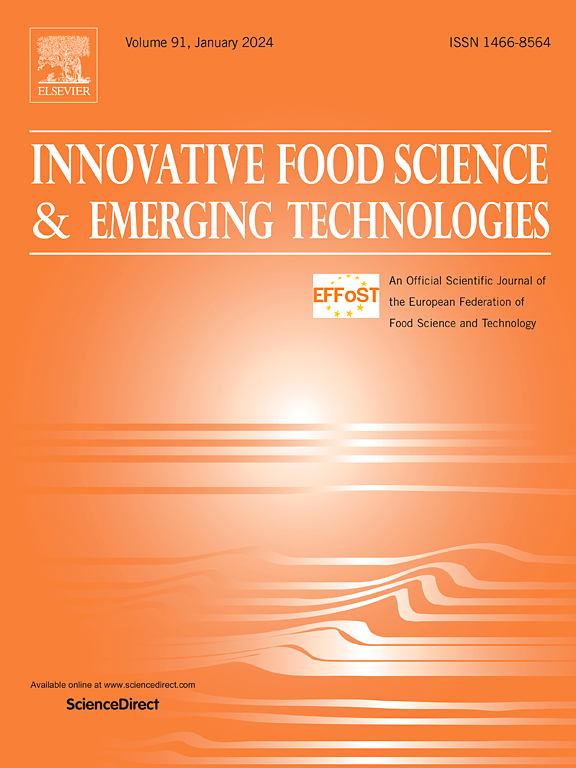创新电子束技术验证新鲜带壳鸡蛋沙门氏菌灭活动力学:一种预测建模方法
IF 6.3
1区 农林科学
Q1 FOOD SCIENCE & TECHNOLOGY
Innovative Food Science & Emerging Technologies
Pub Date : 2025-01-01
DOI:10.1016/j.ifset.2024.103868
引用次数: 0
摘要
FDA和IFT将新鲜鸡蛋定义为“潜在危险食品”。美国食品药品监督管理局(FDA)规定,在巴氏杀菌鸡蛋中必须灭活≥5 log的肠炎沙门氏菌(SE)。在美国,只有大约1%的鸡蛋经过巴氏杀菌,电子束用于减少新鲜壳鸡蛋中的SE和鼠伤寒沙门氏菌。双面电子束吸收剂量均匀性良好(1.43 kGy)。建立了吸收剂量预测模型并进行了验证。SE在TSA和XLD上的d值分别为0.34±0.006和0.33±0.018 kGy。鼠伤寒沙门氏菌(P <;0.05),分别为0.40±0.007和0.39±0.009 kGy。建立了沙门氏菌灭活预测模型并进行了验证。3和5 kGy的双面电子束分别使SE降低≥13.0 log和≥21.7 log;鼠伤寒沙门氏菌减少,分别为≥11.1 log和≥18.5 log。预测模型表明,较低剂量(如1.25 kGy的双面电子束)可使SE降低≥5对数,符合FDA要求。工业相关性:这项工作与非热食品加工有关,特别是与已经包装在标准零售容器中的新鲜壳蛋中的沙门氏菌的非热灭活有关。在这项工作中使用电子束来减少沙门氏菌而不加热,以符合或超过目前美国食品和药物管理局(FDA)针对肠炎沙门氏菌≥5对数破坏的要求。本文章由计算机程序翻译,如有差异,请以英文原文为准。
Innovative E-beam technology for validation of Salmonella inactivation kinetics in fresh shell eggs: A predictive modeling approach
FDA and IFT defined fresh shell eggs as “potentially hazardous food”. By FDA, ≥5-log of Salmonella Enteritidis (SE) must be inactivated in pasteurized eggs. Only about 1 % of eggs are pasteurized in the U.S. E-beam was used to reduce SE and S. Typhimurium in fresh shell eggs. Two-sided e-beam showed adequate uniformity of dose absorbed (1.43 kGy). Predictive model for dose absorbed was developed and validated. D-value for SE was 0.34 ± 0.006 and 0.33 ± 0.018 kGy on TSA and XLD, respectively. S. typhimurium was more (P < 0.05) radio-resistant at 0.40 ± 0.007 and 0.39 ± 0.009 kGy, respectively. Predictive model for Salmonella inactivation was developed and validated. Two-sided e-beam at 3 and 5 kGy resulted in ≥13.0-log and ≥ 21.7-log reduction of SE, respectively; while S. typhimurium was reduced at ≥11.1-log and ≥ 18.5-log, respectively. The predictive model indicated that lower doses such as 1.25 kGy of two-sided e-beam would result in FDA compliance for ≥5-log reduction of SE.
Industrial relevance
This work is relevant to non-thermal food processing, specifically to non-thermal inactivation of Salmonella in fresh shell eggs that are already packed in a standard retail container. Electron beam was used in this work to reduce Salmonella without heat to comply or exceed current U.S. Food and Drug Administration (FDA) requirements targeting ≥5-log destruction of Salmonella Enteritidis.
求助全文
通过发布文献求助,成功后即可免费获取论文全文。
去求助
来源期刊
CiteScore
12.00
自引率
6.10%
发文量
259
审稿时长
25 days
期刊介绍:
Innovative Food Science and Emerging Technologies (IFSET) aims to provide the highest quality original contributions and few, mainly upon invitation, reviews on and highly innovative developments in food science and emerging food process technologies. The significance of the results either for the science community or for industrial R&D groups must be specified. Papers submitted must be of highest scientific quality and only those advancing current scientific knowledge and understanding or with technical relevance will be considered.

 求助内容:
求助内容: 应助结果提醒方式:
应助结果提醒方式:


